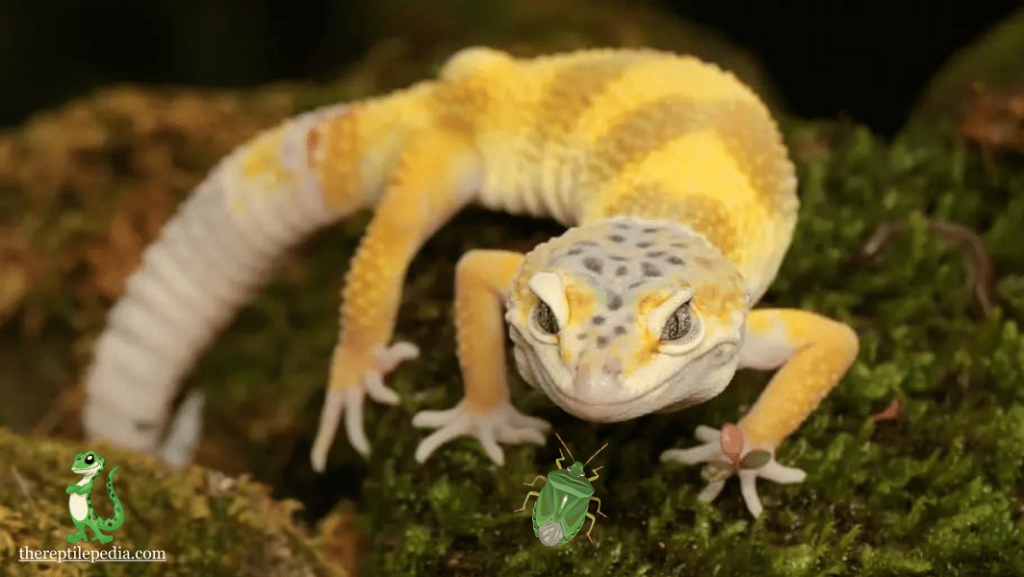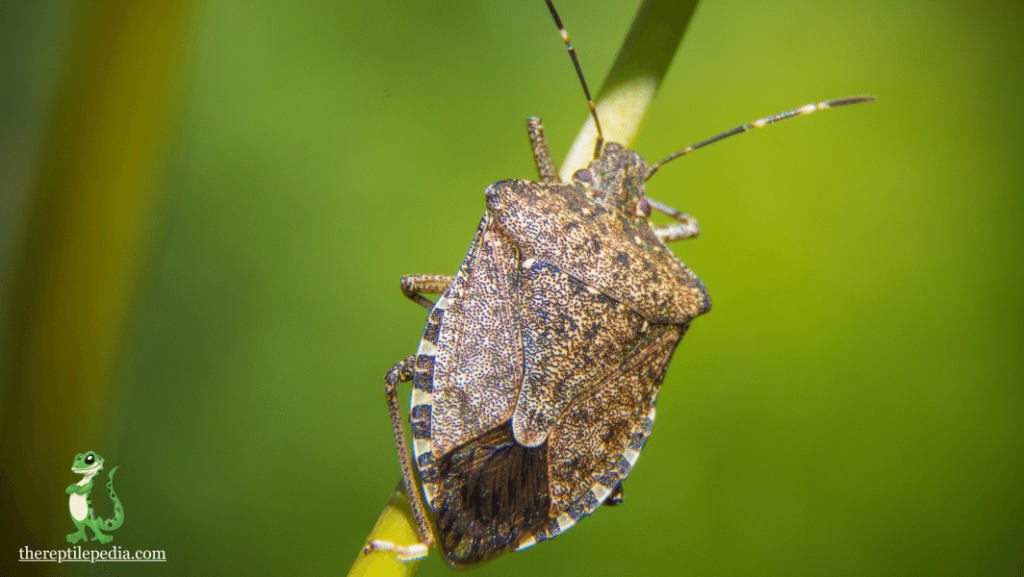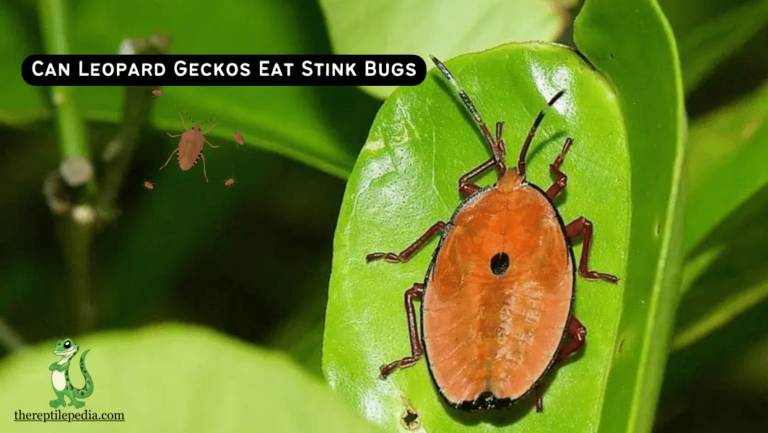As a long-time Leo owner, I’ve always been curious about the availability and low cost options for feeding my Leopard Geckos. Among the many options, stink bugs often come up as a potential food option. Regrettably, the idea isn’t as terrific as it sounds. Stink bugs, known for their unpleasant smell, might not just be an undesirable choice for your pets; they could also negatively affect your Leo’s health.
Leopard Gecko owners often discuss the dislike these geckos have for the taste of stink bugs. More importantly, consuming these bugs can be detrimental. Their hard exoskeletons are difficult to digest, posing a risk. Additionally, stink bugs might carry parasites and pesticides, which can further affect the well-being of our beloved geckos. In essence, they are an undesirable choice for a reptile that’s already picky about its food.
Table of Contents
Can Leopard Geckos Eat Stink Bugs?
In the diverse world of insects, stink bugs stand out due to their unique chemical defenses, a trait evolved to ward off predators. This brings us to the intriguing question: Can leopard geckos safely consume these bugs? As an enthusiast and keeper of these fascinating reptiles, I’ve often pondered over the availability of various insects as a potential snack. In certain regions, stink bugs are plentiful, making them a tempting and easily offering. However, it’s not as straightforward as it seems.
The gecko’s decision to eat or ignore these bugs can significantly influence their health. While these geckos have evolved to eat a variety of insects, the chemical defenses of stink bugs pose a unique challenge. It’s crucial for owners to consider these factors before offering such a meal. Balancing the natural dietary habits of leopard geckos with the potential risks involved in consuming certain insects like stink bugs is key to maintaining their health and well-being.
Do Leopard geckos like eating stink bugs?

In the diet of Leopard geckos, the inclusion of stink bugs raises questions due to their unique characteristics. While these geckos are generally known to eat any insect that can fit in their mouth and is alive, stink bugs may be an exception. Their foul odor, a natural defense mechanism, could significantly influence a gecko’s taste preferences, leading them to avoid or even spit out these insects. Given the wide range of insect options available, stink bugs are not typically the last snack choice for Leopard geckos, who tend to select their food based on both size and palatability, steering clear of items with strong, unpleasant scents.
Why Gecko Owners Dislike Dealing with Stink Bugs
Handling a stink bug is an experience most gecko owners find unpleasant. Although these insects do not bite and are not dangerous to humans, their defense mechanism poses a unique problem. When disturbed, stink bugs release a foul-smelling stench, a stinky liquid that can linger on your hands for several hours. This stench is not only hard to eliminate but also makes working with them far from a pleasurable task.
For gecko owners, the prospect of their pet eating a stink bug and releasing this odor inside their habitat is a concern. The foul-smelling liquid, while not harmful, creates an environment that is unpleasant for both the gecko and the owner. Therefore, despite stink bugs being harmless, their notorious stench makes them a less desirable choice for those involved in the day-to-day care of leopard geckos.
Should you offer stink bugs to your Leo?
In autumn, when stink bugs become more prevalent around our homes and gardens, keeping them away from your Leo should be a priority. If you notice signs of these pests, consider temporarily covering your gecko’s enclosure with a screen or mesh to prevent them from entering the tank. Never use insecticide to eliminate stink bugs, as your Leo might unintentionally eat the contaminated bugs and could die. Instead, opt for a natural deterrent spray by mixing lavender oil, dishwashing liquid, and water. Many Leopard Gecko owners also swear by catnip as an effective alternative.
Planting catnip around your house is a strategic move for preventing stink bug infestation. Other plants like Garlic, radishes, marigold, chrysanthemum, lavender, and thyme also aid in deterring these pests. Keep your outdoor lighting off to correct the attraction of bugs. Ensure your home’s damp areas are clean and maintain a dust-free environment. If you store wood, it should be stored at least 20 feet (6 meters) away from your home, and ensure that household garbage is regularly removed. These techniques can significantly reduce the number of stink bugs, keeping your Leopard Geckos safe and your home pest-free.
Also Read: Why Is Your Leopard Gecko Digging?
Other Stink Bug Removal Tips
To manage and catch stink bugs before they get near your Leo’s tank, creating a stink bug-free environment is crucial. When you catch these bugs, it’s important to dispose of them in a way that doesn’t give off their notorious chemicals which can attract more bugs, exacerbating the problem. Luckily, killing stink bugs does not always have to be a messy affair. Dropping them into a solution containing a tablespoon of white vinegar can kill them immediately and eliminate them without releasing their smell. This method is simple yet effective, ensuring that your leopard gecko’s space remains comfortable and stink bug-free.
What exactly is a stink bug?

The brown marmorated stink bug, scientifically known as Halyomorpha halys, belongs to the Pentatomidae family. Originating from Asia, particularly Japan, China, and Korea, this species has now spread to North America, South America, and Europe. These bugs are known for their various colors, typically recognized by their dark brown back and a creamy white to light brown underbelly.
They feed on over 100 types of plants, making them a widespread agricultural pest. What makes them particularly notorious is their unfortunate stench, a defense mechanism against predators. Interestingly, in their non-native regions, such as North America, they have no natural predators, which has allowed their population to grow substantially.
How and why do stink bugs smell?
Stink bugs have a smell that’s a bit like cilantro (coriander), but stronger. They get this odor from a special chemical made in a gland in their abdomen. When they feel threatened or if they’re squashed, they spray this chemical. It’s their way of protecting themselves, kind of like a defense mechanism. This smell is strong and can stick around for a while, but it’s not dangerous.
The odor of stink bugs is quite distinctly herby, similar to skunk or cilantro. They use this smell to keep predators away. It’s made up of chemicals that they can spray out when they need to. Even though it’s really strong and can be annoying, it’s just their natural way of staying safe.
Drawbacks of Stink Bugs in Leopard Gecko Diets
Foul Smell
The smell of stink bugs often discourages leopard geckos from eating them. If you offer these bugs to your pet lizard, you might find them left untouched in the cage, as geckos can bite and spit them out due to the bad smell. In addition, the foul smell can linger not just in the gecko’s habitat but also throughout your house, making it unpleasant. This stink is a natural defense mechanism of the bugs, but it also leads geckos to avoid them as a food source. This reaction from your pet leopard gecko highlights why stink bugs are generally not recommended as part of their diet.
Toxin and Pesticide Concerns with Wild-Caught Stink Bugs
A significant drawback of feeding stink bugs to leopard geckos is the potential toxins and chemicals these bugs may carry. When stink bugs are collected from the wild, they often have ingested or touched various substances that can be harmful. Being plant-eating, these stinking bugs often eat plants that might have been sprayed with pesticides. If a gecko consumes a stink bug with such residues, it can become sick, and this can negatively affect their overall growth and health. Therefore, caution is advised when considering wild-caught stink bugs as a food source for your leopard gecko.
Risk of Impaction Due to Chitin
Stink bugs, being insects, have a tough outer layer called chitin, which is largely undigestible for leopard geckos. Consumption of these bugs can cause impaction, a condition where chitin accumulates in the gecko’s digestive system, hindering their digestion. This can make your pet leopard gecko quite uncomfortable. Therefore, it’s important to be aware of this potential issue when considering stink bugs as part of their diet.
Also Read: Leopard Gecko Pale And White
Can Leopard Geckos Consume June Bugs?
Yes, Leopard geckos can indeed eat June bugs. However, it’s important to consider that while they can consume these bugs, it may not be the best idea. Feeding your gecko wild bugs like June bugs can be challenging because these bugs may carry parasites, pesticides, or even be poisonous. It’s generally safer and more convenient to provide your pet with a controlled diet of insects from a reputable source to ensure their well-being.
Final Thoughts:
In conclusion,it’s crucial to emphasize the importance of maintaining a stink bug-free environment for your Leopard Gecko. Opt for safe and reliable insect options from your local exotic pet store, ensuring your pet’s health and well-being. Vigilance in supervising your Leo’s enclosure and taking preventive measures around your home will help deter these pesky bugs, keeping your Leopard Gecko thriving and free from any unwanted odors. Your commitment to their care is the key to a happy and stink-free life for your beloved pet.
FAQs:
-
What bugs can leopard geckos not eat?
Leopard geckos should avoid eating stink bugs, fireflies, and any insects that have a hard exoskeleton. These bugs can be difficult for geckos to digest and may cause health issues. It’s best to offer softer and safer insect options like mealworms, crickets, and dubia cockroaches.
-
What food is toxic to leopard geckos?
Leopard geckos should not be fed toxic or harmful foods, such as stink bugs, fireflies, and insects sprayed with pesticides. These can be detrimental to their health and well-being. It’s essential to provide safe and nutritious insect options from reputable sources to ensure the well-being of your pet gecko.
-
What is a geckos favorite food?
Geckos primarily enjoy eating insects like crickets, mealworms, and roaches. Their diet can vary depending on the species, but most geckos are insectivores. Providing a balanced diet enriched with essential nutrients is crucial for their health. Occasionally, some gecko species may also eat fruits or nectar.

